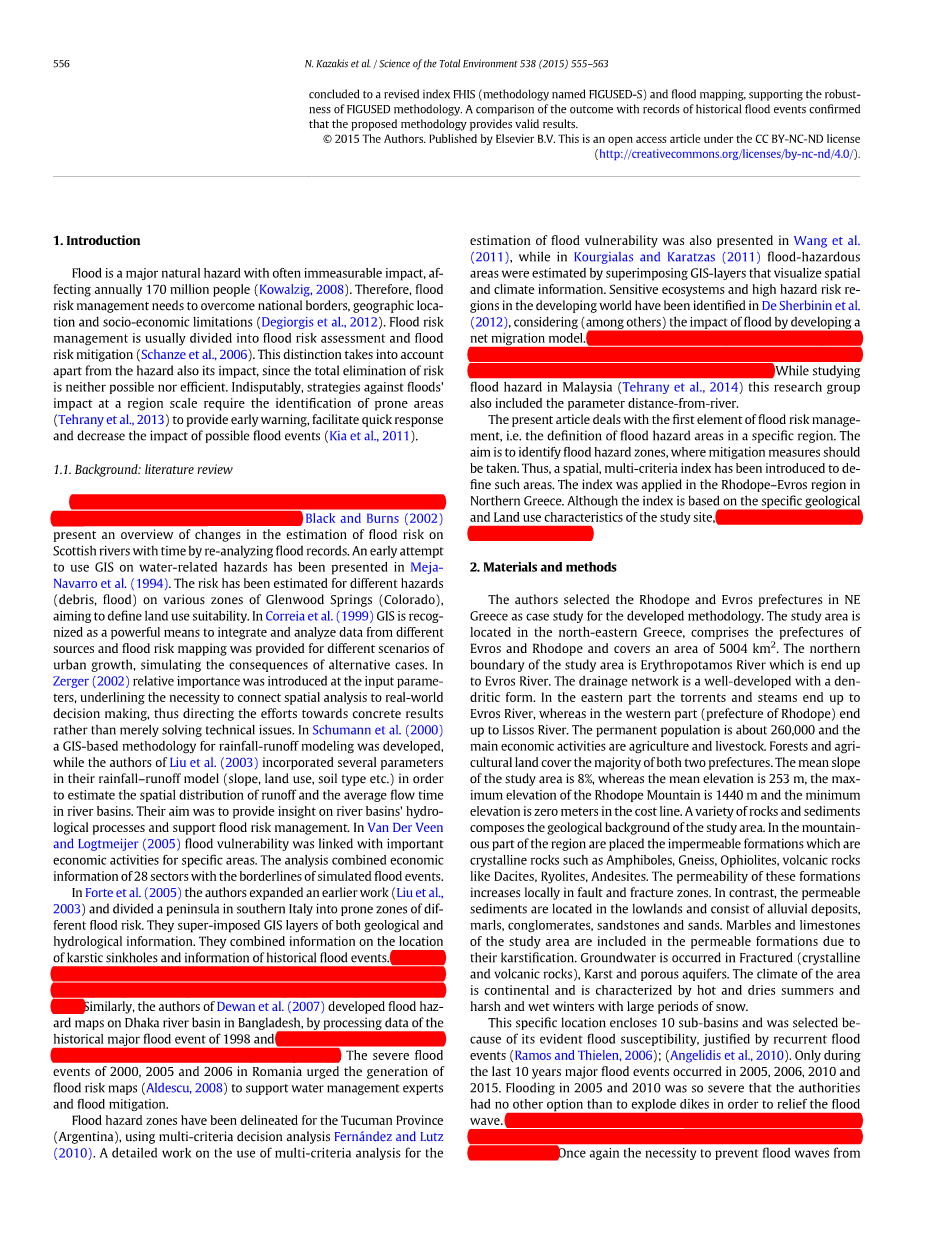本科毕业设计(论文)
外文翻译
Assessment of flood hazard areas at a regional scale using an index-based approach and Analytical Hierarchy Process: Application in Rhodope–Evros region, Greece
作者:Nerantzis Kazakis, Ioannis Kougias, Thomas Patsialis
国籍:Greece
出处:Science of the Total Environment
原文正文:(小四)
ABSTRACT
The present study introduces a multi-criteria index to assess flood hazard areas in a regional scale. Accordingly, a Flood Hazard Index (FHI) has been defined and a spatial analysis in a GIS environment has been applied for the estimation of its value.
The developed methodology processes information of seven parameters namely flow accumulation, distance from the drainage network, elevation, land use, rainfall intensity and geology. The initials of these criteria gave the name to the developed method: “FIGUSED”. The relative importance of each parameter for the occurrence and severity of flood has been connected to weight values. These values are calculated following an “Analytical Hierarchy Process”, a method originally developed for the solution of Operational Research problems. According to their weight values, information of the different parameters is superimposed, resulting to flood hazard mapping. The accuracy of the method has been supported by a sensitivity analysis that examines a range for the weights values and corresponding to alternative scenarios.
The presented methodology has been applied to an area in north-eastern Greece, where recurring flood events have appeared. Initially FIGUSED method resulted to a Flood Hazard Index (FHI) and a corresponding flood map. A sensitivity analysis on the parameters values revealed some interesting information on the relative importance
of each criterion, presented and commented in the Discussion section. Moreover, the sensitivity analysis concluded to a revised index FHIS (methodology named FIGUSED-S) and flood mapping, supporting the robustness of FIGUSED methodology. A comparison of the outcome with records of historical flood events confirmed that the proposed methodology provides valid results.
1.Introduction
Flood is a major natural hazard with often immeasurable impact, affecting annually 170 million people (Kowalzig, 2008). Therefore, flood risk management needs to overcome national borders, geographic location and socio-economic limitations (Degiorgis et al., 2012). Flood risk management is usually divided into flood risk assessment and flood risk mitigation (Schanze et al., 2006). This distinction takes into account apart from the hazard also its impact, since the total elimination of risk is neither possible nor efficient. Indisputably, strategies against floods impact at a region scale require the identification of prone areas(Tehrany et al., 2013) to provide early warning, facilitate quick response and decrease the impact of possible flood events (Kia et al., 2011).
1.1.Background: literature
The application of GIS-based multi-criteria analysis in the context of flood risk assessment was rare until 2000. Black and Burns (2002) present an overview of changes in the estimation of flood risk on Scottish rivers with time by re-analyzing flood records. An early attempt to use GIS on water-related hazards has been presented in Meja-Navarro et al. (1994). The risk has been estimated for different hazards(debris, flood) on various zones of Glenwood Springs (Colorado),aiming to define land use suitability. In Correia et al. (1999) GIS is recognized as a powerful means to integrate and analyze data from different sources and flood risk mapping was provided for different scenarios of urban growth, simulating the consequences of alternative cases. In Zerger (2002) relative importancewas introduced at the input parameters, underlining the necessity to connect spatial analysis to real-world decision making, thus directing the efforts towards concrete results rather than merely solving technical issues. In Schumann et al. (2000) a GIS-based methodology for rainfall-runoff modeling was developed, while the authors of Liu et al. (2003) incorporated several parameters in their rainfall–runoff model (slope, land use, soil type etc.) in order to estimate the spatial distribution of runoff and the average flow time in river basins. Their aim was to provide insight on river basins hydrological processes and support flood risk management. In Van Der Veen and Logtmeijer (2005) flood vulnerability was linked with important economic activities for specific areas. The analysis combined economic information of 28 sectors with the borderlines of simulated flood events.
In Forte et al. (2005) the authors expanded an earlier work (Liu et al.,2003) and divided a peninsula in southern Italy into prone zones of different flood risk. They super-imposed GIS layers of both geological and hydrological information. They combined information on the location of karstic sinkholes and information of historical flood events. Thematic maps visualizing this information have been supported by geo-lithological, permeability and rainfall maps, producing a flood hazard map. Similarly, the authors of Dewan et al. (2007) developed flood hazard maps on Dhaka river basin in Bangladesh, by processing data of the historical major flood event of 1998 and considering the interactive effect of land cover, elevation and geomorphology. The severe flood events of 2000, 2005 and 2006 in Romania urged the generation of flood risk maps (Aldescu, 2008) to support water management experts and flood mitigation.
Flood hazard zones have been delineated for
剩余内容已隐藏,支付完成后下载完整资料


英语原文共 9 页,剩余内容已隐藏,支付完成后下载完整资料
资料编号:[276463],资料为PDF文档或Word文档,PDF文档可免费转换为Word
以上是毕业论文外文翻译,课题毕业论文、任务书、文献综述、开题报告、程序设计、图纸设计等资料可联系客服协助查找。
您可能感兴趣的文章
- 带水印的GIS数字矢量地图质量监测外文翻译资料
- 基于多源地理数据的城市功能区识别——以中国郑州市为例外文翻译资料
- 北京医疗服务可及性的空间差异和影响机制:移徙者平等的视角外文翻译资料
- 利用巴基斯坦费萨拉巴德的光学多时相卫星数据进行陆地表面温度和土地利用土地覆盖变化的CA-马尔可夫链分析外文翻译资料
- 大都市地区植被净初级生产力(NPP)动态变化与城市化驱动力研究–以北京市为例外文翻译资料
- 公园缓解城市热岛效应的有效性–以亚的斯亚贝巴为例外文翻译资料
- 一种描述新罕布夏州肺癌发病空间格局的地理计算方法外文翻译资料
- 加拿大大温哥华地区极端炎热天气温度-死亡率关系的空间差异描述外文翻译资料
- 雅典地区气温和湿度对人体热舒适度的影响外文翻译资料
- 量化公共卫生实践和研究中的空间可及性:在现场酒精场所的应用,美国,2013年外文翻译资料


